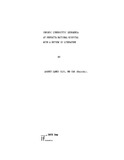| dc.contributor.author | Oloo, Agrey J | |
| dc.date.accessioned | 2013-05-24T13:31:49Z | |
| dc.date.available | 2013-05-24T13:31:49Z | |
| dc.date.issued | 1982 | |
| dc.identifier.citation | Master of medicine ,University of Nairobi,1982. | en |
| dc.identifier.uri | http://erepository.uonbi.ac.ke:8080/xmlui/handle/11295/25474 | |
| dc.description.abstract | A study to find out the main clinical features of present ation,
the clinical course, and laboratory f ind ings for patients
with chronic lymphocytic Ieukemi a (eIL), as seen at Kenyatta
National Hospital (KNH), Nairobi was carried out during the
calender year 1981. Also done, was a review of literature on
this disorder. The study period covered the years 1976 to 1981
both inclusive.
A total of 42 patients were studied, 29 of them retrospectively
and 13 prospectively. TIlere were 29 males and 13 females
providing a sex ratio of 1:2.2 (F:M). The age range was J.7to
78, with a mefu'1of 54±14 (1 SD). All the patients were of
African origin.
The most frequent clinical sign was splenomegally - present
in 80% of the patients. Hepatomegally and lymphadenopathy was
noted in 76% and 64% respectively. Abdominal pains and dtscomtor-t
was the most frequent symptom and was recorded in 52% of the
patients.
Concurrent infections was corrrron, 81% had detectable
respiratory infections; among whom 23% had pulmonary tuberculosis.
Hemoglobin values below 12 G:n/dl was recorded in 7'Z70of the
patients. Nearly 1/3 had absolute lymphocyte count above 100,000
per mm3^
Disease stagi.ng (according to Rai, 1975) revealed no patient
in stage 0, 26% In stages I and II, and 75% in stages III and
IV combined.
35% of the patients were seen within six months of the onset
of symptoms, while 42% presented after 6 months. Patient
compliance was poor with a default rate of 69% noted in this
study. 21% were still being followed up at the clinic by the
close of the study. 4 deaths, constituting 9% of the patients
were noted. Chest infections and ill1ernia were the main tenninal
events.
Remission was observed in 66% of 18 patients of whom there
was adequate data to enable labelling as remission. Most patients
were treated with Chlorambucil and Prednisone. The study is
concluded with a resume of a case report of a patient who had
very severe disease ill1dmultiple complications. | en |
| dc.language.iso | en | en |
| dc.publisher | University of Nairobi | en |
| dc.title | Chronic lymphocytic leukaemia at Kenyatta National Hospital with a review of llterature | en |
| dc.type | Thesis | en |
| dc.description.department | a
Department of Psychiatry, University of Nairobi, ; bDepartment of Mental Health, School of Medicine,
Moi University, Eldoret, Kenya | |
| local.publisher | Medicine | en |

